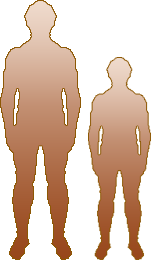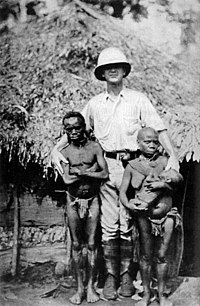Pygmy peoples
This article needs attention from an expert on the subject. Please add a reason or a talk parameter to this template to explain the issue with the article. |
Generally speaking, pygmy can refer to any human or animal of unusually small size (e.g. pygmy hippopotamus).

In an anthropological context, a Pygmy is specifically a member of one of the hunter-gatherer people living in equatorial rainforests characterised by their short height (below 1.5 metres, or 4.5 feet, on average). Pygmies are found throughout central Africa, with smaller numbers in south-east Asia (see Negrito). Members of so-called Pygmy groups often consider the term derogatory, instead preferring to be called by the name of their ethnic group (e.g., Baka, Mbuti).
The most closely studied group are the Mbuti of the Ituri Rainforest in the Democratic Republic of the Congo, which were the subject of the study The Forest People (1962) by Colin Turnbull. Among the other African groups are the Aka, BaBenzelé, Baka, Binga, Efé, Twa, and Wochua. In the Central African Republic, at least, the term Bayaka is preferred to Pygmy, as it refers to the people and not only to their stature.
Pygmies are smaller because in their early teens they do not experience the growth spurt normal in most other humans. This is an environmental adaptation, called insular dwarfism; smaller bodies have evolved independently in non-human species in response to isolation on small islands or dense forest environments. By natural selection, the environments in which the ancestors to Pygmies lived favored decreased body size over many generations, and today they dominate the gene pool.
The African Pygmies are particularly known for their vocal music, characterised by dense polyphony, group performance and improvisation. French-Israeli ethnomusicologist Simha Arom says that the level of polyphonic complexity of Pygmy music resembles that of European ars nova polyphony. Most pygmy musical instruments are simple and portable, suitable to a traditionally nomadic lifestyle. Pygmy societies are renowned (perhaps romanticized) for their egalitarianism. They are often romantically portrayed as both utopian and "premodern", which overlooks that they have long had relationships with more "modern" non-pygmy groups (such as inhabitants of nearby villages, agricultural employers, logging companies, evangelical missionaries and commercial hunters encroaching on their food sources). African Pygmies seem to have given up their own languages in favor of those spoken by the more dominant surrounding non-Pygmy peoples, who are usually Bantu.

The homes of Pygmies of the Republic of the Congo, precisely between the towns of Ouesso and Pokola, along the Sangha River, are made of sticks and leaves; they are very small and equipped with the basic items such as a bed and shelves, which are all made from wood. Because in the rainy forest it is quite cold during the night, they usually keep an ongoing small fire inside. They are accustomed to produce homemade alcohol by distilling corn or other available fruits; they are also very good hunters.
Among the Asian groups are the Agta and the Batak (in the Philippines), the Semang (on the Malay Peninsula) and the residents of the Andaman Islands.
Some scientists classify Homo floresiensis as a pygmy rather than a different species of Homo, but given the available information on Homo floresiensis and protocol for naming species, this classification is bizarre (see article).
Myth
In Greek myth, pygmies were a tribe of people 27" tall (about 68.5cm) in India who warred with cranes.
"Beyond these in the most outlying mountain region we are told of the Three-Span (Trispithami) Pygmae who do not exceed three spans, that is, twenty-seven inches, in height; the climate is healthy and always spring-like, as it is protected on the north by a range of mountains; this tribe Homer has also recorded as being beset by cranes. It is reported that in springtime their entire band, mounted on the backs of rams and she-goats and armed with arrows, goes in a body down to the sea and eats the cranes' eggs and chickens, and that this outing occupies three months; and that otherwise they could not protect themselves against the flocks of cranes would grow up; and that their houses are made of mud and feathers and egg-shells. Aristotle says that the Pygmies live in caves, but in the rest of this statement about them he agrees with the other authorities." -- Pliny Natural History 7.23-30
External links
- Baka Pygmies Culture, music and life of Baka Pygmies, by Mauro Campagnoli
- "What We Learned From the Pygmies", from Awake! Jehovah’s Witnesses magazine (November 8, 2003)
- Bread for Life, Inc.: Pygmy Project
- Congo's Unreached
See also
Researchers who studied pygmy cultures:
